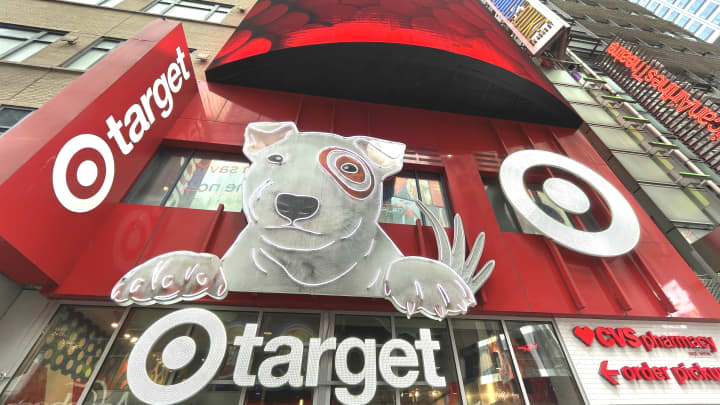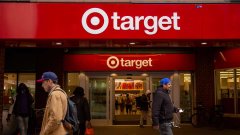
on Tuesday posted holiday-quarter revenue and earnings that topped Wall Street's expectations, but the company said it expects another year of weak sales.
The Minneapolis-based retailer's shares closed about 12% higher as it showed progress in boosting profits and margins.
Even so, Target's comparable sales declined for the third quarter in a row. The key metric, which includes digital sales and takes out the impact of store openings, closures and renovations, fell 4.4% in the fiscal fourth quarter.
Target doesn't anticipate sales will bounce back quickly. For the current quarter, the company said it expects comparable sales to drop by between 3% and 5% and adjusted earnings per share to range from $1.70 to $2.10. Target said it expects full-year 2024 comparable sales to be flat to up 2% and adjusted earnings per share to range from $8.60 to $9.60.
Yet Target stressed its progress after a rough stretch marked by lower discretionary spending. Store and website traffic, while still down year over year, improved for the second quarter in a row. Profits jumped as the company better managed inventory and benefited from falling supply chain, freight and e-commerce fulfillment costs. And an emphasis on lower price points resonated with shoppers.
In an interview Tuesday with CNBC's " ," CEO Brian Cornell said the company has made "really solid progress" in managing inventory better and becoming more efficient. He said the retailer will focus on "growing traffic and making sure that we make Target a growth company again."
One of those new sales drivers for the year ahead will be , Target Circle 360, which will aim to spur delivery orders.
Target wants to attract customers by offering fresh merchandise and affordable price points in the year ahead, too. At an investor day in New York City, company leaders spoke about some of those growth areas: It's rolling out a new toy brand, Gigglescape, with plush stuffed animals, books and games. In the spring, it will debut a limited-time collection of clothing, accessories and more designed with fashion brand Diane von Furstenberg. And it is catering to budget-conscious customers by overhauling and expanding Up&Up, its essentials brand that includes personal care items, pet items and more, and launching other low-priced brands.
Here's what the retailer reported compared with what Wall Street was expecting, based on a survey of analysts by LSEG, formerly known as Refinitiv:
Target's sluggish sales have reflected a pullback in discretionary spending over the past two years, especially after huge pandemic-driven gains. Its annual total revenue grew by about $31 billion – or nearly 40% – from fiscal 2019 to 2022 before sales leveled out. Target also said it took a hit in recent quarters from and for Pride month.
The company expects losses from shrink, an industry term used to describe losses due to theft, damage or vendor fraud, will be flat year over year, Chief Operating Officer Michael Fiddelke said. He attributed that to efforts taken to stop theft in some parts of the country and by initiatives by Target, which has stepped up asset protection and locked up more of its items at some stores.
To attract shoppers, Target has emphasized value and more frequently bought categories, such as food and beauty. Over the holiday season, for example, Target touted a wide assortment of gifts and for under $25.
Last month, it launched a new low-priced private brand called Dealworthy, with products like socks, paper towels, laundry detergent and more. Most items cost under $10.
That value focus will continue. At the investor event on Tuesday, Chief Growth Officer Christina Hennington said cooling inflation has led to a gradual uptick in discretionary spending at Target.
Yet she said shoppers still feel stretched. She said Target expects consumers "will remain highly value conscious" and will seek out promotions.
Target's profits have suffered along with its sales. But the retailer made more money in the fourth quarter than it did a year ago, as it marked down fewer items and had more products in stock.
Target's net income for the three-month period rose by nearly 58% to $1.38 billion, or $2.98 per share, from $876 million, or $1.89 per share in the year-ago quarter. That was significantly higher than Target's forecast range of between $1.90 and $2.60 per share.
Its margins also were healthier compared with a year ago. Its fourth-quarter operating income margin rate was 5.8% compared with 3.7% in the year-ago quarter, a time when Target's results took a hit as customers bought fewer higher-margin items like clothing, and more of lower-margin ones, such as food and household essentials.
In the fiscal fourth quarter that ended Feb. 3, Target's total revenue grew nearly 2% from $31.40 billion in the Those results got a boost from an additional week of sales compared with fiscal 2022.
Comparable sales dropped in stores and online. Comparable store sales fell 5.4% year over year. Digital sales declined 0.7% year over year, marking an improvement from the 6% drop
The sequential improvement in traffic trends – from a 4.1% decline in the third quarter to a 1.7% decline in the fourth quarter – was fueled by more shoppers using curbside pickup.
As of Tuesday's close, Target's shares are up more than 17% so far this year. That beats out the approximately 6% gains of the S&P 500 during the same period. Target's shares closed Tuesday at $168.58, bringing the company's market value to $77.83 billion.
Correction: In the fiscal fourth quarter, Target's total revenue grew nearly 2% from $31.40 billion in the year-ago period. An earlier version misstated a figure.
Don't miss these stories from CNBC PRO:




